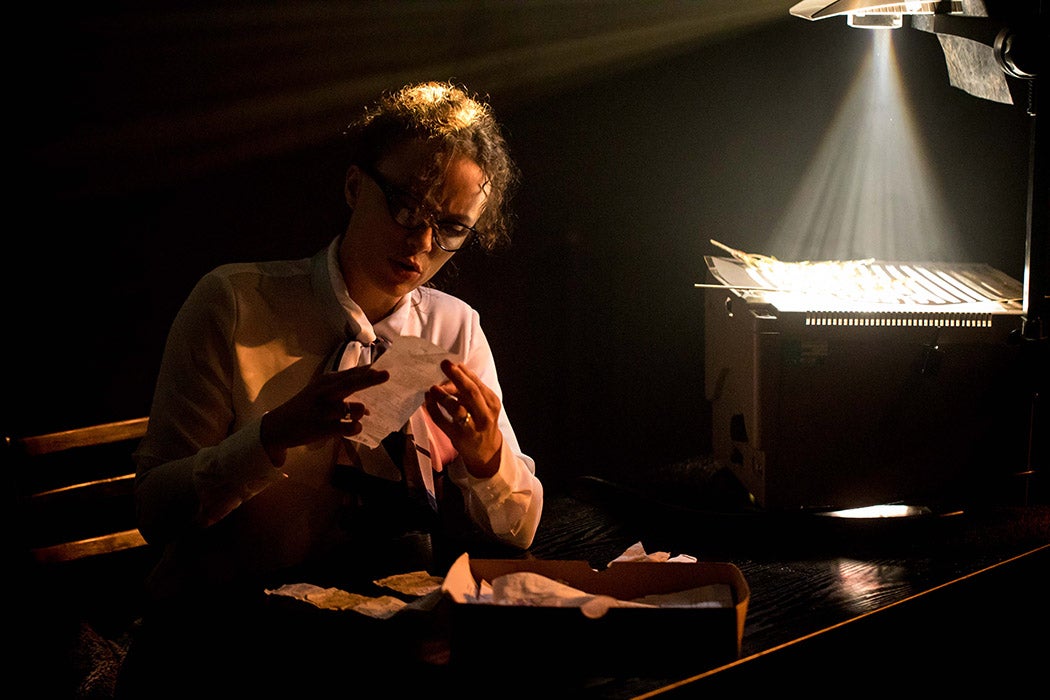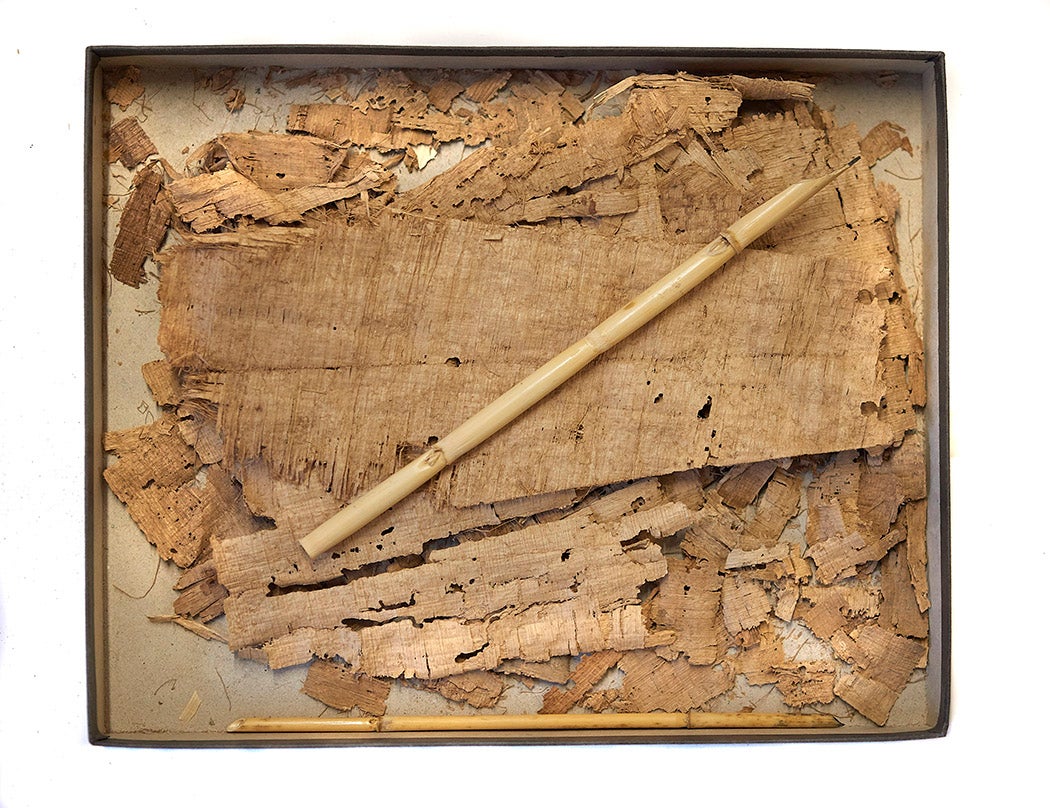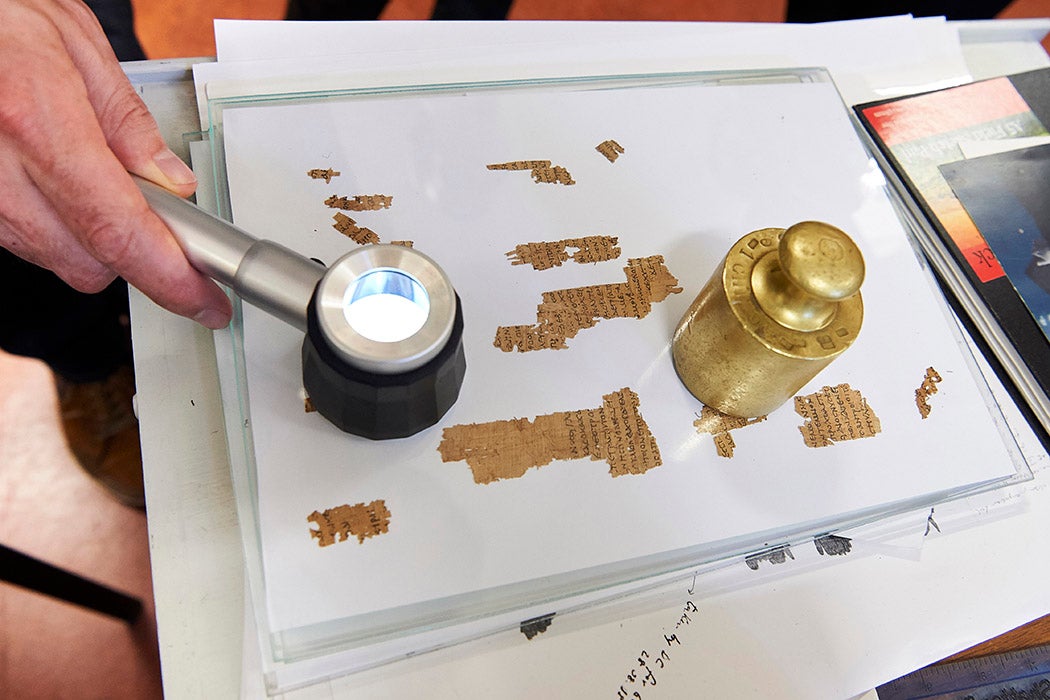Only thirty-two full-length Greek tragedies have survived into the modern age. Written by just three men, Aeschylus, Euripides, and Sophocles, these works represent a tiny fraction of those that would have been performed at the grand theater festivals of ancient Athens, beginning in the fifth century BCE. Of the more than 300 known tragedies from that era, the vast majority exist only as fragments, tantalizing glimpses of imaginative worlds that remain frustratingly out of reach.
Or maybe not. Although just half a scene and a handful of broken lines are all that remain of Cresphontes, a revenge tragedy by Euripides, the British theater company Potential Difference has put the play at the heart of its latest work, Fragments. Set in the papyrology department of a fictional university, the play (on tour in the UK until May 13) centers on a trio of papyrology scholars attempting to decipher the drama of Cresphontes from a handful of badly damaged scraps of text. As they do so, the ancient drama comes to life around them through puppetry and song.
Russell Bender, artistic director of Potential Difference and co-writer and director of Fragments, wasn’t interested in simply trying to resurrect an ancient play. Theater companies produce modern interpretations of Greek tragedies all the time; Bender wanted to do something different, to celebrate, he explained, “the gaps and how we fetishize what’s left.”

The myth of Cresphontes, which we know from the writings of later authors, tells the story of a young man who secretly returns to his birthplace to avenge the murder of his father, the late king at the hands of his uncle, Polyphontes. Just a baby at the time of his father’s death, Cresphontes is smuggled to safety by his grandfather, while his two brothers are killed by their uncle. His mother, Merope, is then made to marry her husband’s murderer against her will. The drama climaxes when Cresphontes reaches adulthood and his mother mistakenly thinks he is a bounty hunter hired by Polyphontes to murder her son. She is stopped from killing him in the nick of time.
There are certainly plenty of gaps in the text for Bender and Dr. Laura Swift, his co-author and a tutorial fellow in classics at the University of Oxford, to celebrate. The text, such as it is, includes around 100 lines of text gathered from two papyri written 400 years apart, and ten brief references found elsewhere. Together these offer a glimpse of the action, never a full picture. What we know straight from Euripides is that Cresphontes vows to avenge his father after disguising himself and inquiring at the palace about his death; that a chorus of old men comment on the troubled state of play in the royal household; and that Merope bemoans her fate.
Weekly Newsletter
Even with so little to go on, says Bender, “it’s inspiring to work with this text.” Firstly, there’s the sheer drama of the plot, which would have made Cresphontes “really quite an exciting, engaging play,” says Swift. “Given that this isn’t a myth that we think the audience would have been familiar with, there would have been genuine suspense and excitement,” she explains. “Particularly given that tragedy often does end in disaster, the audience could have really been at the edge of their seats thinking, ‘Oh god, she’s going to kill her own son.’”
Then there’s the fact that the events of the play lend themselves to an exploration of how we, as humans, respond when faced by experiences or memories that are fragmentary in nature. “We chose it because it felt like we could reasonably make a case that people in the play are operating without a full picture of what is going on,” says Bender.
“We were trying to find a play where there’s a link to some sort of fragmented experience in the story as well as in the fragments. It is essentially built around a series of misunderstandings and people making assumptions.”
Assumption, as it turns out, is a key element of papyrological interpretation. Reading the ancient Greek of papyrus fragments is a very different experience from reading as we know it. As Herbert C. Youtie writes in a seminal essay on the process of papyrology, “The scribes do not divide their texts into words and sentences, nor do they generally make any attempt to conform to the orthodox spellings of the schools.” This is because the people of that era were so in the habit of reading aloud that they were able to glean spacing and punctuation naturally as they read. Modern readers attempting to interpret these texts have no choice but to make a series of educated guesses at how words should be divided, based on their knowledge of the language and the context.

Complicated as that process is, papyrologists then face the additional task of dealing with the idiosyncrasies of ancient handwriting, including accidental errors by scribes in a hurry to get their work done. Transcription errors among papyrologists are worryingly frequent, writes Youtie; in an analysis of the published texts of 250 papyri and ostraca (pieces of pottery) alongside their originals, he finds that the letter alpha is mistaken for 21 out of 24 letters of the alphabet. When you extrapolate these figures out for the entire alphabet, single letters as well as groupings, the scale of the problem becomes clear.
On top of that, there’s the issue of the advanced age and state of decay of the papyri. The smaller of the two Cresphontes papyri, which is thought to date from the second century BCE, offers a case in point: having been dissolved from mummy cartonnage probably found in the Egyptian city of Faiyum, it sustained considerable water damage and is full of holes and abrasions. “Ink has been washed over the entire piece,” writes Katherine Lu Hsu, the author of the first papyrology paper on this particular fragment. “It has left deceptive smudges (specks, sometimes even strokes) and offsets of writing in many places. The last lines of col. 1 (86-95) look almost as if they were written on blotting paper. Such damage is an inconvenience when the text is preserved entire; in fragmentary areas, however, it becomes a major obstacle.”
These obstacles notwithstanding, analysis of the smaller, older Cresphontes papyrus proved extremely useful when it came to deciphering the meaning of the larger one, which actually consists of a number of individual fragments. Discovered in the Egyptian city of Oxyrhynchus and dating from the third century AD, this group of fragments was published in 1962 by the eminent papyrologist E.G. Turner. By comparing the two papyri side by side, Hsu is able to posit, for example, that the text of the Oxyrhynchus papyrus, rather than an anthology of separate scenes of Euripides’ play, “represents a continuous portion of the text from the prologue of the play right up to and including parts of the parados” (the first song sung by the chorus at the start of a Greek tragedy). The earlier text also makes clear the chorus, previously assumed to be women, are old men, based on evidence from other works by Euripides.
A lay reader wishing to get a sense of the task facing papyrologists need only glance at the photographs of the Cresphontes papyri included in Hsu’s article: the tattered scraps of ancient paper, lined up in careful order yet full of gaps and splits, have the feel of a treasure map from a child’s pirate story—one that refuses to yield its spoils. The deep textual analysis that follows is almost as baffling: Hsu’s writing is interposed with plentiful Greek script and the square brackets and ellipses that denote missing text or a guess as to meaning.
The idea that all these complicated workings can lead to a more or less complete understanding of a text is extraordinary to consider. E.G. Turner puts it neatly when he describes the layman’s sense of the papyrologist as “that of a ‘back-room’ wizard producing something out of nothing.”
For Swift, who is not a papyrologist but works with published papyri in her research on fragmentary classical Greek poetry, the process of papyrology is akin to trying to complete a badly manufactured jigsaw puzzle. “You might have two different papyri and you can piece them together, but it’s not a perfect jigsaw puzzle because there might be a word that is different where one scribe has made a mistake,” she explains.
Discrepancies between texts are undoubtedly problematic, but our awareness of the gaps in our knowledge means we can at least attempt to work around them. This isn’t necessarily always a straightforward process however, says Swift. “We think we’re terribly objective as scholars, but actually scholars are still human beings, and we are unconsciously filling the gaps with our own assumptions. These might be assumptions based on our knowledge and the limitations of our knowledge, but they might also be assumptions to do with personality and confidence and ethical judgement.”
To help bring this slippery search for meaning to life on stage, Bender has opted for a form of shadow puppetry involving a manual overhead projector (OHP). A nod to the lightboxes used by papyri conservators, the OHP allows puppeteer Jess Mabel Jones to reveal the intricate details of papyrus fragments and mimic the process of working with papyri. The fragments then become, in Bender’s words, “magically embellished,” with letters and images disappearing and reappearing before the astonished eyes of the play’s papyrologist characters (and its audience).
Puppetry works well as a visual metaphor for papyrus fragments, Bender believes, because “you’re seeing something that is in no way realistic and going into an act of imagining. It felt very compelling in terms of a literal, direct response to what’s going on when we’re confronted with a fragment and we fill in the gaps.”
When Bender and Swift first began working on Fragments, back in 2014, there wasn’t much academic interest in what Swift calls “fragmentary drama.”
“People who worked on tragedy who were interested in literary or cultural questions only really looked at the extant plays because there’s quite a lot of them and there’s plenty to be getting on with,” she says. That’s slowly changing now, with classicists finally beginning to look to the enormous quantity of fragmentary drama languishing unstudied in papyrus collections at universities and museums around the world. This is important, says Swift, because this material has the “potential to really expand our understanding of the genre of tragedy” beyond the work of Aeschylus, Euripides, and Sophocles.
More than that even, “our expectations in the modern world around what does it mean to be a Greek tragedy are quite shaped ultimately by what Greek tragedies survived,” she says. “But that probably wasn’t representative of what the genre was originally like. It was probably a lot more diverse, and had a lot of plays that, for example, might have had happy endings or might not have had single dominant figures who made mistakes that led to their downfall.”
Once we start properly delving into the fragments of these works, and really explore shadowy figures like Cresphontes, Merope, and Polyphontes, who knows what riches we might find.
Editor’s Note: This article was updated to correct a typographical error in the first line.







